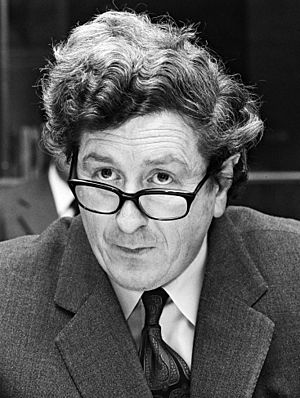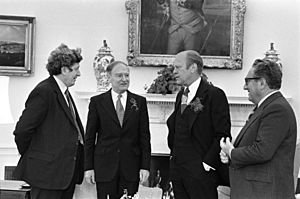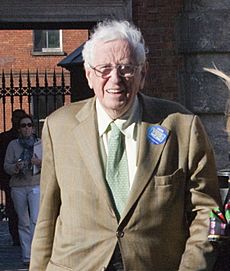Garret FitzGerald facts for kids
Quick facts for kids
Garret FitzGerald
|
|
|---|---|

FitzGerald in 1975
|
|
| 8th Taoiseach | |
| In office 14 December 1982 – 10 March 1987 |
|
| President | Patrick Hillery |
| Tánaiste |
|
| Preceded by | Charles Haughey |
| Succeeded by | Charles Haughey |
| In office 30 June 1981 – 9 March 1982 |
|
| Tánaiste | Michael O'Leary |
| Preceded by | Charles Haughey |
| Succeeded by | Charles Haughey |
| Leader of the Opposition | |
| In office 10 March 1982 – 14 December 1982 |
|
| President | Patrick Hillery |
| Taoiseach | Charles Haughey |
| Preceded by | Charles Haughey |
| Succeeded by | Charles Haughey |
| In office 5 July 1977 – 30 June 1981 |
|
| Taoiseach |
|
| Preceded by | Jack Lynch |
| Succeeded by | Charles Haughey |
| Leader of Fine Gael | |
| In office 1 July 1977 – 10 March 1987 |
|
| Deputy | Peter Barry |
| Preceded by | Liam Cosgrave |
| Succeeded by | Alan Dukes |
| Minister for Foreign Affairs | |
| In office 14 March 1973 – 5 July 1977 |
|
| Taoiseach | Liam Cosgrave |
| Preceded by | Brian Lenihan |
| Succeeded by | Michael O'Kennedy |
| Teachta Dála | |
| In office June 1969 – November 1992 |
|
| Constituency | Dublin South-East |
| Senator | |
| In office 23 June 1965 – 18 June 1969 |
|
| Constituency | Industrial and Commercial Panel |
| Personal details | |
| Born | 9 February 1926 Ballsbridge, Dublin, Ireland |
| Died | 19 May 2011 (aged 85) Phibsborough, Dublin, Ireland |
| Resting place | Shanganagh Cemetery, Shankill, Dublin, Ireland |
| Political party | Fine Gael |
| Spouse |
Joan O'Farrell
(m. 1947; died 1999) |
| Relations | Eithne (daughter-in-law) |
| Children | 3, including John |
| Parents |
|
| Education | Belvedere College |
| Alma mater |
|
| Occupation |
|
| Nickname | "Garret the Good" |
Garret Desmond FitzGerald (9 February 1926 – 19 May 2011) was an important Irish politician. He was a member of the Fine Gael political party. He served twice as Taoiseach (Ireland's Prime Minister), first from 1981 to 1982, and again from 1982 to 1987.
Before becoming Taoiseach, he led the Fine Gael party from 1977 to 1987. He was also the Leader of the Opposition twice. From 1973 to 1977, he was the Minister for Foreign Affairs. FitzGerald was a Teachta Dála (TD), which is a member of the Irish parliament, from 1969 to 1992. He was also a Senator from 1965 to 1969.
His father, Desmond FitzGerald, was the first foreign minister of the Irish Free State. Garret FitzGerald was also an economist and a journalist.
Contents
Early Life and Education
Garret FitzGerald was born in Ballsbridge, Dublin, in 1926. His parents were Desmond FitzGerald and Mabel McConnell Fitzgerald. His father was a key figure in the creation of the Irish Free State. He supported the Anglo-Irish Treaty of 1921.
Garret's mother, Mabel, was a nationalist with Protestant roots from Ulster. She later became Catholic. FitzGerald wanted to create an Ireland where people from all backgrounds felt at home.
He went to Belvedere College and University College Dublin (UCD). He earned a degree in history, French, and Spanish in 1946. Later, he got a PhD in economics in 1968. His doctoral paper was about "Planning in Ireland."
In 1947, he married Joan O'Farrell. They had three children: John, Mary, and Mark.
After university, he worked for Aer Lingus, Ireland's national airline, until 1958. He became an expert in transport economics. He also wrote many articles for newspapers and magazines like The Economist. Later, he became an economics lecturer at UCD. He also qualified as a barrister and spoke French very well.
Start in Politics
FitzGerald wanted to get into politics. He joined the Fine Gael party. He was part of the party's liberal group.
He was first elected as a Senator in 1965. This helped him become well-known in politics. In 1969, he was elected to Dáil Éireann (the Irish Parliament) for the Dublin South-East area. He quickly became an important person in the party.
Minister for Foreign Affairs (1973–1977)

After the 1973 election, Fine Gael formed a coalition government with the Labour Party. Liam Cosgrave became Taoiseach. FitzGerald became Minister for Foreign Affairs. It was the same job his father had held 50 years earlier.
During his time as Foreign Minister, Ireland had just joined the European Economic Community (EEC), which later became the European Union (EU). FitzGerald was very active in European affairs. His new ideas and his ability to speak French helped Ireland gain a strong voice in Europe. Ireland's first time leading the European Council in 1975 was a big success because of him.
FitzGerald also wanted to change some laws in Ireland. He believed in a more open society. He tried to change laws that were based on Catholic teachings, like the ban on divorce. However, the Church did not agree with these changes.
Leading Fine Gael
In 1977, Fine Gael and Labour lost the general election. Liam Cosgrave stepped down as party leader. FitzGerald was chosen to take his place.
As the new Leader of the Opposition, he worked to make Fine Gael stronger and more modern. Under his leadership, Fine Gael grew quickly in popularity.
Taoiseach (1981–1982)
By the 1981 election, Fine Gael was very strong. The party won 65 seats. They formed a minority coalition government with the Labour Party. FitzGerald became Taoiseach on 30 June 1981.
He faced two main challenges: Northern Ireland and a difficult economy. There was a hunger strike in Northern Ireland in 1981. FitzGerald met with families of the hunger strikers. He said the republican movement was to blame for the strike.
The economy was also in trouble. His government had to introduce strict budget cuts. This led to the government losing a vote in the Dáil (parliament) in January 1982. FitzGerald then asked the President, Patrick Hillery, to call a new election. The President agreed.
In the election in February 1982, Fine Gael lost a few seats. They were out of office. However, after another election in November 1982, FitzGerald became Taoiseach again. He led a Fine Gael–Labour coalition with a strong majority.
Taoiseach (1982–1987)
FitzGerald's second term was also dominated by a deep economic recession. His government tried to control public spending to reduce the national debt. This caused some tension with the Labour Party. However, FitzGerald worked well with his Tánaiste (Deputy Prime Minister), Dick Spring. This helped the government stay together for over four years.
The government stopped the financial crisis from getting worse. But they struggled to create economic growth. With high unemployment, FitzGerald's government was not very popular.
Changing the Constitution
As Taoiseach, FitzGerald wanted to make Irish society more open. He tried to allow divorce by holding a referendum in 1986. However, the public voted against it.
Working for Peace in Northern Ireland
In 1983, FitzGerald set up the New Ireland Forum. This brought together political parties from the Republic of Ireland and nationalist parties from Northern Ireland. Even though some parties didn't join, the Forum helped start new talks between the Irish and British governments.
These talks led to the Anglo-Irish Agreement in November 1985. This agreement allowed the Republic of Ireland to be consulted by the British government about Northern Ireland. Unionists in Northern Ireland strongly opposed this agreement.
The agreement helped build trust between the two governments. It laid the groundwork for future peace efforts, like the Downing Street Declaration in 1993. This eventually led to cease-fires by republican and loyalist groups.
In 1984, FitzGerald was invited to speak to the US Congress. He was the fourth Irish leader to do so.
End of Government
In January 1987, the Labour Party left the government due to disagreements over budget plans. Without a majority, FitzGerald called another election. In the 1987 election, Fine Gael lost many seats. Fianna Fáil returned to power in March 1987.
After Being Taoiseach

FitzGerald stepped down as leader of Fine Gael after the 1987 election. He retired from politics completely in 1992. His autobiography, All in a Life, was published in 1991 and became a bestseller. His wife, Joan, passed away in 1999.
After retiring, FitzGerald wrote a weekly column for The Irish Times. He also gave many lectures about public affairs. He continued to support European integration. He campaigned for a "yes" vote in referendums on the EU's Treaty of Nice (2002) and Treaty of Lisbon (2009).
From 1997 to 2009, he was the Chancellor of the National University of Ireland. He was also vice-president of the Railway Preservation Society of Ireland for 20 years.
Illness and Death
Garret FitzGerald became seriously ill in May 2011. He died on 19 May 2011, at the age of 85, from pneumonia.
Many people paid tribute to him. Irish President Mary McAleese said he "constantly strove to make Ireland a better place." Taoiseach Enda Kenny called him "a truly remarkable man." US President Barack Obama said FitzGerald "believed in the potential of peace and who lived to see that peace realised."
His death happened during Queen Elizabeth II's visit to Ireland. This visit marked the progress of the Northern Ireland peace process, which FitzGerald had helped start.
FitzGerald was buried at Shanganagh Cemetery.
Governments Led
Garret FitzGerald led these Irish governments:
- 17th Government of Ireland (June 1981 – March 1982)
- 19th Government of Ireland (December 1982 – March 1987)
Honorary Degrees
FitzGerald received honorary doctorates from several universities:
- 1985: Saint Mary's University (Canada)
- 1986: Keele University (UK)
- 1987: Boston College (US)
- 1991: National University of Ireland (Ireland)
- 1999: Trinity College Dublin (Ireland)
- 2003: Ulster University (UK)
- 2011: Open University (UK)
Images for kids
See also
 In Spanish: Garret FitzGerald para niños
In Spanish: Garret FitzGerald para niños








